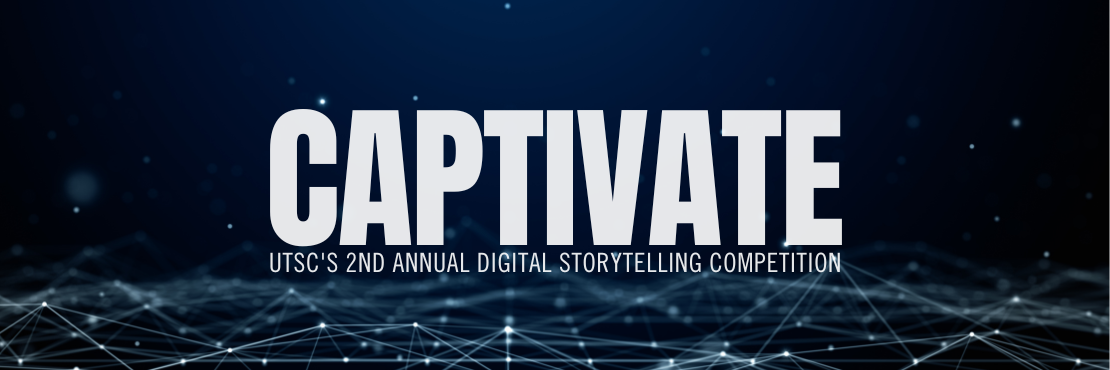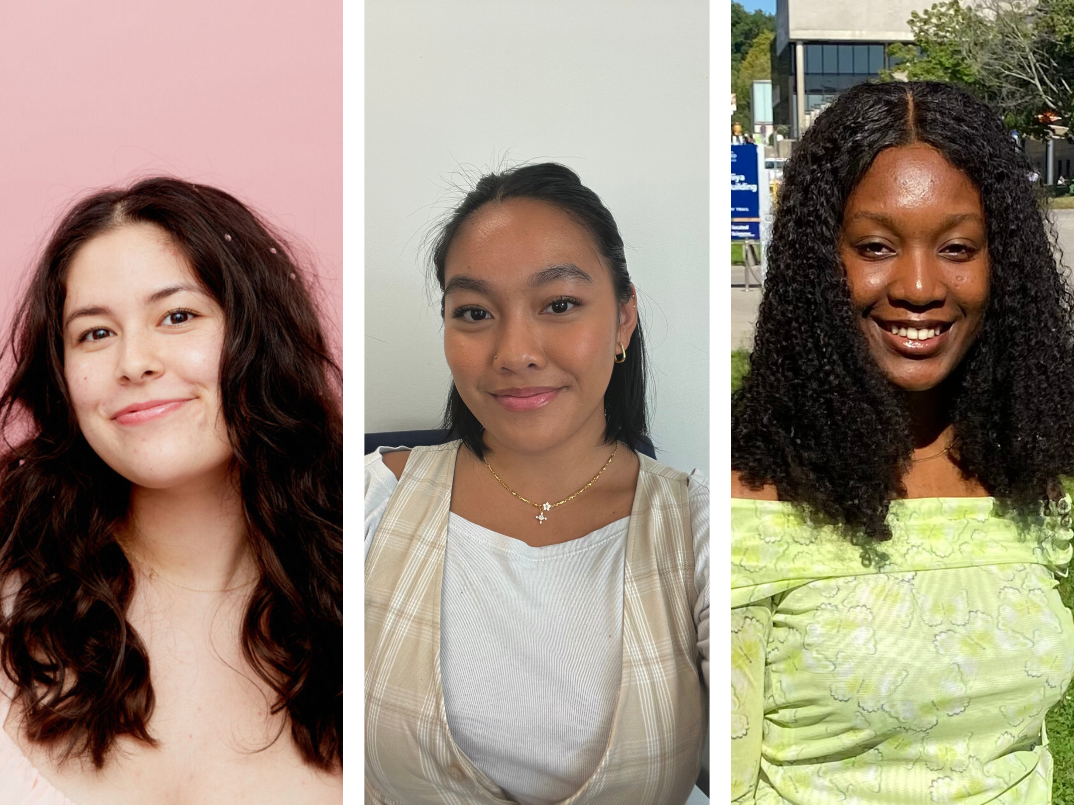What is Captivate?
Welcome to Captivate: UTSC's 2nd Annual Digital Storytelling Competition. Create a short digital story—a video, podcast, website, or another format—that tells YOUR story, and compete to win cash prizes.
How to sign up?
Register for the competition here by September 30, 2023.
This initiative honours Sandford Borins, Professor Emeritus of Public Management, who was a faculty member of the Department of Management at UTSC from 1990 to 2020.
Learn key skills every student and new graduate needs, including how to:
- Engage audiences with innovative, compelling content.
- Work with digital tools and diverse teams.
- Structure stories that entertain, educate, and resonate emotionally.
- Understand the storyteller’s role in advancing equity, diversity, and inclusion.
Learn from expert storytellers

(L-R Professor Emeritus Sandford Borins, Adam Rodricks, Ravisha Mall, Sakura Lee, Ray Xu)
Competition Overview
| Date | Event | Description | Location |
|---|---|---|---|
| Wed Sept 20, 2 pm - 4 pm | Competition Kick-off: The Art of Digital Storytelling | Learn from amazing guest speakers and professional storytellers, enjoy tasty food, and get all the details for how to join the competition. Registration is required. | Catalyst Center, EV Ground Floor |
| Sept 20 - October 18 | UTSC Library Digital Storytelling Portal | Learn the fundamentals of digital storytelling at your own pace with the UTSC Library's Essentials of Digital Storytelling module. Topics such as accessibilty, copyright, video/podcast editing will also be included! | Virtual, self-paced |
| September 22, 11 am - 1 pm | Telling Accessible Digital Stories | Captivate ALL audiences by learning how to make your content accessible! In this workshop, you will gain skills to remove access barriers for digital content consumers. |
The BRIDGE, IC Ground Floor (Recording available after the workshop) |
| September 28, 3 pm - 4 pm | Need help making your story accessible? | Attend this virtual drop-in and ask your accessibility questions. | Virtual, optional |
| October 4, 2 pm - 3 pm | Need help on your story? | Drop in to work on your project. If you have questions about a particular tool, such as concept mapping, storyboarding, sketching, storymaps, or audio or video editing tools, we are here to help! | The BRIDGE, IC Ground Floor, optional |
| October 4, 3 pm - 4 pm | Need help making your story accessible? | Attend this virtual drop-in and ask your accessibility questions. | Virtual, optional |
| October 18 11:59 pm | SUBMISSION DEADLINE | Submit your creation in the UTSC Library Digital Storytelling Portal | Online via Quercus |
| Nov 8 2 pm - 4 pm | Captivate Final Presentations & Awards Ceremony | From the top 5 to the top 3, our judges will evaluate the digital stories, provide meaningful feedback and select the winners! | Catalyst Center, EV Ground Floor |
Awards and Prizes!
Winners of the Captivate competition will receive the Sandford Borins Award in Digital Communications along with the following prizes:
-
First Place
-
Have your story featured on U of T social media channels and gain exposure!
-
$400 gift certificate
-
-
Second Place
-
Have your story featured on U of T social media channels and gain exposure!
-
$200 gift certificate
-
-
Third Place
-
Have your story featured on U of T social media channels and gain exposure!
-
$100 gift certificate
-
Competition Guidelines
To maximize your learning experience, we strongly encourage you to complete the online modules and attend the workshops & drop-in sessions.
| Date | Event | Description | Location |
|---|---|---|---|
| Wed Sept 20, 2 pm - 4 pm | Competition Kick-off: The Art of Digital Storytelling | Learn from amazing guest speakers and professional storytellers, enjoy tasty food, and get all the details for how to join the competition. Registration is required. | Catalyst Center, EV Ground Floor |
| Sept 20 - October 18 | UTSC Library Digital Storytelling Portal | Learn the fundamentals of digital storytelling at your own pace with the UTSC Library's Essentials of Digital Storytelling module. Topics such as accessibilty, copyright, video/podcast editing will also be included! | Virtual, self-paced |
| September 22, 11 am - 1 pm | Telling Accessible Digital Stories | Captivate ALL audiences by learning how to make your content accessible! In this workshop, you will gain skills to remove access barriers for digital content consumers. |
The BRIDGE, IC Ground Floor (Recording available after the workshop) |
| September 28, 3 pm - 4 pm | Need help making your story accessible? | Attend this virtual drop-in and ask your accessibility questions. | Virtual, optional |
| October 4, 2 pm - 3 pm | Need help on your story? | Drop in to work on your project. If you have questions about a particular tool, such as concept mapping, storyboarding, sketching, storymaps, or audio or video editing tools, we are here to help! | The BRIDGE, IC Ground Floor |
| October 4, 3 pm - 4 pm | Need help making your story accessible? | Attend this virtual drop-in and ask your accessibility questions. | Virtual, optional |
| October 18 11:59 pm | SUBMISSION DEADLINE | Submit your creation in the UTSC Library Digital Storytelling Portal | Online via Quercs |
| Nov 8 2 pm - 4 pm | Captivate Final Presentations & Awards Ceremony | From the top 5 to the top 3, our judges will evaluate the digital stories, provide meaningful feedback and select the winners! | Catalyst Center, EV Ground Floor |
All submissions must meet the following requirements to be eligible for the competition prizes:
- Submitted by October 18, 11:59 pm
- Must contain additional files to support accessibility. Submissions without the appropriate files will not be eligible for inclusion in our digital collections. For audio and video files, you must submit a .webvtt file, which is a file format containing time codes and text. For images and other submissions, you must submit a text description of the content appropriate for an individual using a screen reader.
- By submitting your work, you (the author(s) or copyright owner) grants to University of Toronto the non-exclusive right to reproduce, translate (as defined below), and/or distribute your submission worldwide in print and electronic format and in any medium, including but not limited to audio or video.
- By submitting your work, you represent that the submission is your original work, and that you have the right to grant the rights contained in this license. You also represent that your submission does not, to the best of your knowledge, infringe upon anyone's copyright
- By submitting your work, you acknowledge that U of T will clearly identify your name(s) as the author(s) or owner(s) of the submission, and will not make any alteration, other than as allowed by this license, to your submission.
|
Medium |
Length |
File formats |
Examples |
|
Video |
Max 3 minutes |
.mov, .mp4, .mkv |
short film, video interview, music video |
|
Audio |
Max 3 minutes |
.mp3, .mp4, .avi, .wav |
song, podcast, audio recording |
| Images | N/A | .jpeg, .jpg, .png, .tiff, .pdf | image, collage, infographic |
|
Presentation |
Max 3 minutes to view |
.pptx, .pdf |
Slide show |
|
Websites |
Max 3 minutes to view |
.url |
ARCGIS StoryMaps, web application, website, link to video |
|
Other |
Other formats must be pre-approved. Contact us! |
|
|
| 4 | 3 | 2 | 1 | |
| A point (of view) | A point, understanding of an issue or reason for the story is clearly communicated using digital media (text, audio, images, video, music, etc) | A point, understanding of an issue or reason for the story is somewhat communicated using digital media. | A point, understanding of an issue or reason for the story is not communicated well using digital media. | The story does not have a point. |
| Dramatic Question (Action/Conflict) | Holds the audience’s attention by posing and answering a dramatic question or includes significant action or a related conflict that is clearly understood by the audience. | Somewhat holds the audience’s attention by posing and answering a dramatic question or includes significant action or a related conflict that is clearly understood by the audience. | Is somewhat distracting or hard to follow the dramatic question, action, or conflict. | Does not hold the audience’s attention because it does not pose a dramatic question, action, or conflict. |
| Pacing | The pace (rhythm and voice punctuation) fits the story line and helps the audience really "get into" the story. | Occasionally moves too fast or too slowly for the story line. The pacing (rhythm and voice punctuation) is relatively engaging for the audience. | Tries to use pacing (rhythm and voice punctuation), but it is often noticeable that the pacing does not fit the story line. Audience is not consistently engaged. | No attempt to match the pace of the storytelling to the story line or the audience. |
| Economy | The story composition is told with exactly the right amount detail throughout. It does not seem too short nor does it seem too long. | The story composition is typically good, though it seems to drag somewhat OR need slightly more detail in one or two sections. | The story seems to need more editing. It is noticeably too long or too short in more than one section. | The story needs extensive editing. It is too long or too short to be interesting |
| Use of media (maps, video, audio, music, image, etc.) | Effective use of media to stir a rich emotional response, and create a distinct atmosphere or tone that matches different parts of the story. | Use of media that creates an emotional response that somewhat matches the storyline, and creates some atmosphere or tone that matches different parts of the story. | Use of media is ok and not distracting, but it does not add much to the story; attempts to use media but needs more work. | Use of media is distracting, inappropriate or missing. Little or no attempt to create an appropriate atmosphere or tone. |
| Organization | Story has a strong introduction that draws the audience in and an ending that creates resolution or closure. | Story has a somewhat strong introduction that draws the audience in and an ending that creates resolution or closure. | Story opening or closing needs some work. | Both the opening and closing are weak |
| Citations | Media not created by the author is credited appropriately and creator has sought and submitted UTSC Media Release for all participants in the story. | - | - | Media not created by the author was not cited, and UTSC Media releases were not submitted. (this results in disqualification). |
| Web Accessibility | Story uses format-appropriate accessibility features in how it is created and how it is published (for example, captions, transcription, description of visual information, clear audio). | Story uses many but not all format-appropriate accessibility features in how it is created and how it is published (for example, many but not all of the following: captions, transcription, description of visual information, clear audio). | Story is missing most of the required, format-appropriate accessibility features in how it is created and how it is published (for example, most of the following are not present: captions, transcription, description of visual information, clear audio). | Story did not include accessibility features in how was created or published. |


